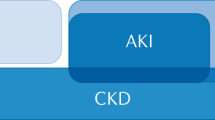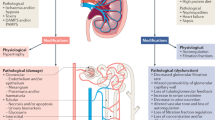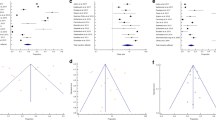Abstract
Renal dysfunction and injury secondary to medications are common, and can present as subtle injury and/or overt renal failure. Some drugs perturb renal perfusion and induce loss of filtration capacity. Others directly injure vascular, tubular, glomerular and interstitial cells, such that specific loss of renal function leads to clinical findings, including microangiopathy, Fanconi syndrome, acute tubular necrosis, acute interstitial nephritis, nephrotic syndrome, obstruction, nephrogenic diabetes insipidus, electrolyte abnormalities and chronic renal failure. Understanding the mechanisms involved, and recognizing the clinical presentations of renal dysfunction arising from use of commonly prescribed medications, are important if injury is to be detected early and prevented. This article reviews the clinical features and basic processes underlying renal injury related to the use of common drugs.
Key Points
-
Renal injury caused by medication can usually be reversed if detected early
-
Drug-induced renal damage can be acute or chronic, prerenal, intrarenal (vascular, tubular, glomerular or interstitial) or postrenal
-
Different drug classes share common mechanisms of inducing renal injury (e.g. toxic, ischemic, inflammatory, obstructive or volume depletion)
-
Electrolyte/acid–base abnormalities are common effects of some medications
-
Medications that can cause kidney damage include diuretics, antihypertensives, immunosuppressants, antiplatelet agents, antivirals, chemotherapeutics, antibiotics and radiocontrast agents
This is a preview of subscription content, access via your institution
Access options
Subscribe to this journal
Receive 12 print issues and online access
$209.00 per year
only $17.42 per issue
Buy this article
- Purchase on Springer Link
- Instant access to full article PDF
Prices may be subject to local taxes which are calculated during checkout
Similar content being viewed by others
References
Han WK and Bonventre JV (2004) Biologic markers for the early detection of acute kidney injury. Curr Opin Crit Care 10: 476–482
Kleinknecht D et al. (1987) Drug-associated acute renal failure: a prospective collaborative study of 81 biopsied patients. Adv Exp Med Biol 212: 125–128
Kaloyandes GJ et al. (2001) Antibiotic and Immunosupression-Related Renal Failure. Philadelphia: Lippincott, Williams & Wilkins
Kleinknecht D (1995) Interstitial nephritis, the nephrotic syndrome, and chronic renal failure secondary to nonsteroidal anti-inflammatory drugs. Semin Nephrol 15: 228–235
Klinkhoff AV and Teufel A (1997) Reinstitution of gold after gold induced proteinuria. J Rheumatol 24: 1277–1279
Wilcox CS (1999) Metabolic and adverse effects of diuretics. Semin Nephrol 19: 557–568
Ellison DH (2001) Diuretic therapy and resistance in congestive heart failure. Cardiology 96: 132–143
Fliser D (1996) Loop diuretics and thiazides—the case for their combination in chronic renal failure. Nephrol Dial Transplant 11: 408–410
Sandhofer A et al. (2002) Severe electrolyte disturbances and renal failure in elderly patients with combined diuretic therapy including xipamid. Wien Klin Wochenschr 114: 938–942
Suki WN (1997) Use of diuretics in chronic renal failure. Kidney Int 59 (Suppl): S33–S35
Cruz J et al. (2004) Successful use of the new high-dose mannitol treatment in patients with Glasgow Coma Scale scores of 3 and bilateral abnormal pupillary widening: a randomized trial. J Neurosurg 100: 376–383
Ejaz P et al. (2004) NSAIDs and kidney. J Assoc Physicians India 52: 632–640
Nankivell BJ et al. (2004) Oral cyclosporine but not tacrolimus reduces renal transplant blood flow. Transplantation 77: 1457–1459
Olyaei AJ et al. (2001) Nephrotoxicity of immunosuppressive drugs: new insight and preventive strategies. Curr Opin Crit Care 7: 384–389
Fang LS et al. (1980) Low fractional excretion of sodium with contrast media-induced acute renal failure. Arch Intern Med 140: 531–533
Van Buren D et al. (1985) De novo hemolytic uremic syndrome in renal transplant recipients immunosuppressed with cyclosporine. Surgery 98: 54–62
Bren A et al. (2005) Follow-up of kidney graft recipients with cyclosporine-associated hemolytic-uremic syndrome and thrombotic microangiopathy. Transplant Proc 37: 1889–1891
Abraham KA et al. (2000) Hemolytic–uremic syndrome in association with both cyclosporine and tacrolimus. Transpl Int 13: 443–447
Lin CC et al. (2003) Tacrolimus-associated hemolytic uremic syndrome: a case analysis. J Nephrol 16: 580–585
Abramowicz D et al. (1992) Induction of thromboses within renal grafts by high-dose prophylactic OKT3. Lancet 339: 777–778
Medina PJ et al. (2001) Drug-associated thrombotic thrombocytopenic purpura-hemolytic uremic syndrome. Curr Opin Hematol 8: 286–293
Chinnakotla S et al. (2000) Clopidogrel-associated thrombotic thrombocytopenic purpura/hemolytic uremic syndrome in a kidney/pancreas transplant recipient. Transplantation 70: 550–552
Izzedine H et al. (2005) Antiviral drug-induced nephrotoxicity. Am J Kidney Dis 45: 804–817
Jackson AM et al. (1984) Thrombotic microangiopathy and renal failure associated with antineoplastic chemotherapy. Ann Intern Med 101: 41–44
Giroux L et al. (1985) Mitomycin-C nephrotoxicity: a clinico-pathologic study of 17 cases. Am J Kidney Dis 6: 28–39
Pisoni R et al. (2001) Drug-induced thrombotic microangiopathy: incidence, prevention and management. Drug Saf 24: 491–501
Venkat KK et al. (1991) Reversal of cyclosporine-associated hemolytic–uremic syndrome by plasma exchange with fresh-frozen plasma replacement in renal transplant recipients. Transplant Proc 23: 1256–1257
Trimarchi HM et al. (1999) FK506-associated thrombotic microangiopathy: report of two cases and review of the literature. Transplantation 67: 539–544
Price TM et al. (1985) Renal failure and hemolytic anemia associated with mitomycin C. A case report. Cancer 55: 51–56
Garibotto G et al. (1989) Successful treatment of mitomycin C-associated hemolytic uremic syndrome by plasmapheresis. Nephron 51: 409–412
Ponticelli C et al. (1977) Late recovery of renal function in a woman with the hemolytic uremic syndrome. Clin Nephrol 8: 367–370
Hauglustaine D et al. (1981) Oestrogen containing oral contraceptives, decreased prostacyclin production, and haemolytic uraemic syndrome. Lancet 1: 328–329
Ruggenenti P and Remuzzi G (1990) Thrombotic thrombocytopenic purpura and related disorders. Hematol Oncol Clin North Am 4: 219–241
Berns JS et al. (1992) Inherited hemolytic uremic syndrome in adults. Am J Kidney Dis 19: 331–334
Kintzel PE (2001) Anticancer drug-induced kidney disorders. Drug Saf 24: 19–38
Walter RB et al. (2002) Gemcitabine-associated hemolytic–uremic syndrome. Am J Kidney Dis 40: E16
Hitti WA and Anderson J (2005) Cholesterol emboli-induced renal failure and gastric ulcer after thrombolytic therapy. South Med J 98: 235–237
Ben-Chitrit S et al. (1994) Cholesterol embolization syndrome following thrombolytic therapy with streptokinase and tissue plasminogen activator. Nephrol Dial Transplant 9: 428–430
Eliot RS et al. (1964) Atheromatous Embolism. Circulation 30: 611–618
Pennington M et al. (2002) Cholesterol embolization syndrome: cutaneous histopathological features and the variable onset of symptoms in patients with different risk factors. Br J Dermatol 146: 511–517
Fine MJ et al. (1987) Cholesterol crystal embolization: a review of 221 cases in the English literature. Angiology 38: 769–784
Lameire N et al. (2005) Acute renal failure. Lancet 365: 417–430
Edelstein CL and Schrier R (2001) Pathophysiology of Ischemic Acute Renal Injury. Philadelphia: Lippincott, Williams & Wilkins
Henrich WL (2005) Nephrotoxicity of several newer agents. Kidney Int 67 (Suppl): S107–S109
Ho ES et al. (2000) Cytotoxicity of antiviral nucleotides adefovir and cidofovir is induced by the expression of human renal organic anion transporter 1. J Am Soc Nephrol 11: 383–393
Nagai J and Takano M (2004) Molecular aspects of renal handling of aminoglycosides and strategies for preventing the nephrotoxicity. Drug Metab Pharmacokinet 19: 159–170
Kaloyanides GJ and Pastoriza-Munoz E (1980) Aminoglycoside nephrotoxicity. Kidney Int 18: 571–582
Cronin RE and Henrich WL (1996) Toxic Nephropathy. Philadelphia: WB Saunders
Maher J (1991) Toxic Nephropathies. Boston: Kluwer Academic Publishers
Patel R and Savage A (1979) Symptomatic hypomagnesemia associated with gentamicin therapy. Nephron 23: 50–52
Taguchi T et al. (2005) Cisplatin-associated nephrotoxicity and pathological events. Contrib Nephrol 148: 107–121
Uehara T et al. (2005) Nephrotoxicity of a novel antineoplastic platinum complex, nedaplatin: a comparative study with cisplatin in rats. Arch Toxicol 79: 451–460
Markowitz GS et al. (2003) Toxic acute tubular necrosis following treatment with zoledronate (Zometa). Kidney Int 64: 281–289
Hiroi-Furuya E et al. (1999) Etidronate (EHDP) inhibits osteoclastic-bone resorption, promotes apoptosis and disrupts actin rings in isolate-mature osteoclasts. Calcif Tissue Int 64: 219–223
Markowitz G et al. (2001) Collapsing focal segmental glomerulosclerosis following treatment with high dose pamidronate. J Am Soc Nephrol 12: 1164–1172
Orbach H et al. (2004) Intravenous immunoglobulin and the kidney—a two-edged sword. Semin Arthritis Rheum 34: 593–601
Khalil M et al. (2000) Macrophagelike vacuolated renal tubular cells in the urine of a male with osmotic nephrosis associated with intravenous immunoglobulin therapy: a case report. Acta Cytol 44: 86–90
Visweswaran P et al. (1997) Mannitol-induced acute renal failure. J Am Soc Nephrol 8: 1028–1033
Ferraboli R et al. (1997) Anuric acute renal failure caused by dextran 40 administration. Ren Fail 19: 303–306
Erdbruegger U et al. (2004) Quiz page: tubular epithelial injury consistent with osmotic nephrosis. Am J Kidney Dis 44: e1
De Labarthe A et al. (2001) Acute renal failure secondary to hydroxyethylstarch administration in a surgical patient. Am J Med 111: 417–418
Hansen-Schmidt S et al. (1996) Osmotic nephrosis due to high-dose immunoglobulin therapy containing sucrose (but not with glycine) in a patient with immunoglobulin A nephritis. Am J Kidney Dis 28: 451–453
Gossmann J et al. (2001) Pathophysiology of cyclosporine-induced nephrotoxicity in humans: a role for nitric oxide? Kidney Blood Press Res 24: 111–115
Andoh TF et al. (1996) Comparison of acute rapamycin nephrotoxicity with cyclosporine and FK506. Kidney Int 50: 1110–1117
Gibbs WJ et al. (2005) Liposomal amphotericin B: clinical experience and perspectives. Expert Rev Anti Infect Ther 3: 167–181
Porter GA (1989) Contrast-associated nephropathy. Am J Cardiol 64: 22E–26E
Mueller C et al. (2002) Prevention of contrast media-associated nephropathy: randomized comparison of 2 hydration regimens in 1620 patients undergoing coronary angioplasty. Arch Intern Med 162: 329–336
Briguori C et al. (2005) New pharmacological protocols to prevent or reduce contrast media nephropathy. Minerva Cardioangiol 53: 49–58
Tepel M et al. (2000) Prevention of radiographic-contrast-agent-induced reductions in renal function by acetylcysteine. N Engl J Med 343: 180–184
Stone GW et al. (2003) Fenoldopam mesylate for the prevention of contrast-induced nephropathy: a randomized controlled trial. JAMA 290: 2284–2291
Vogt B et al. (2001) Prophylactic hemodialysis after radiocontrast media in patients with renal insufficiency is potentially harmful. Am J Med 111: 692–698
Marenzi G et al. (2003) The prevention of radiocontrast-agent-induced nephropathy by hemofiltration. N Engl J Med 349: 1333–1340
Kancha K et al. (2004) Hemofiltration and the prevention of radiocontrast-agent-induced nephropathy. N Engl J Med 350: 836–838; author reply 836–838
Forman JP (2004) Hemofiltration and the prevention of radiocontrast-agent-induced nephropathy. N Engl J Med 350: 836–838; author reply 836–838
Sam AD II et al. (2003) Safety of gadolinium contrast angiography in patients with chronic renal insufficiency. J Vasc Surg 38: 313–318
Rossert J (2001) Drug-induced acute interstitial nephritis. Kidney Int 60: 804–817
Baylor P and Williams K (1999) Interstitial nephritis, thrombocytopenia, hepatitis, and elevated serum amylase levels in a patient receiving clarithromycin therapy. Clin Infect Dis 29: 1350–1351
Tintillier M et al. (2004) Telithromycin-induced acute interstitial nephritis: a first case report. Am J Kidney Dis 44: e25–e27
Szalat A et al. (2004) Acute renal failure and interstitial nephritis in a patient treated with rofecoxib: case report and review of the literature. Arthritis Rheum 51: 670–673
Ra A and Tobe SW (2004) Acute interstitial nephritis due to pantoprazole. Ann Pharmacother 38: 41–45
Clarkson MR et al. (2004) Acute interstitial nephritis: clinical features and response to corticosteroid therapy. Nephrol Dial Transplant 19: 2778–2783
Clive DM and Stoff JS (1984) Renal syndromes associated with nonsteroidal antiinflammatory drugs. N Engl J Med 310: 563–572
Hanabusa H et al. (1999) Renal atrophy associated with long-term treatment with indinavir. N Engl J Med 340: 392–393
Martinez F et al. (1998) Indinavir crystal deposits associated with tubulointerstitial nephropathy. Nephrol Dial Transplant 13: 750–753
Daudon M and Jungers P (2004) Drug-induced renal calculi: epidemiology, prevention and management. Drugs 64: 245–275
Demko TM et al. (1997) Obstructive nephropathy as a result of retroperitoneal fibrosis: a review of its pathogenesis and associations. J Am Soc Nephrol 8: 684–688
Waters VV (1989) Hydralazine, hydrochlorothiazide and ampicillin associated with retroperitoneal fibrosis: case report. J Urol 141: 936–937
Iversen BM et al. (1975) Retroperitoneal fibrosis during treatment with methydopa. Lancet 2: 302–304
Damstrup L and Jensen TT (1986) Retroperitoneal fibrosis after long-term daily use of ergotamine. Int Urol Nephrol 18: 299–301
Perneger TV et al. (1994) Risk of kidney failure associated with the use of acetaminophen, aspirin, and nonsteroidal antiinflammatory drugs. N Engl J Med 331: 1675–1679
Nanra RS et al. (1978) Analgesic nephropathy: etiology, clinical syndrome, and clinicopathologic correlations in Australia. Kidney Int 13: 79–92
Gloor FJ (1978) Changing concepts in pathogenesis and morphology of analgesic nephropathy as seen in Europe. Kidney Int 13: 27–33
Kincaid-Smith P (1980) Analgesic abuse and the kidney. Kidney Int 17: 250–260
Bach PH and Hardy TL (1985) Relevance of animal models to analgesic-associated renal papillary necrosis in humans. Kidney Int 28: 605–613
Akhund L et al. (2003) Celecoxib-related renal papillary necrosis. Arch Intern Med 163: 114–115
Blohme I and Johansson S (1981) Renal pelvic neoplasms and atypical urothelium in patients with end-stage analgesic nephropathy. Kidney Int 20: 671–675
McCredie M et al. (1986) Phenacetin and papillary necrosis: independent risk factors for renal pelvic cancer. Kidney Int 30: 81–84
Busauschina A et al. (2004) Cyclosporine nephrotoxicity. Transplant Proc 36: 229S–233S
Markowitz GS et al. (2000) Lithium nephrotoxicity: a progressive combined glomerular and tubulointerstitial nephropathy. J Am Soc Nephrol 11: 1439–1448
Rojek A et al. (2005) Altered expression of selected genes in kidney of rats with lithium-induced NDI. Am J Physiol Renal Physiol 288: F1276–1289
Cutting HO (1971) Inappropriate secretion of antidiuretic hormone secondary to vincristine therapy. Am J Med 51: 269–271
Steele TH et al. (1973) Antidiuretic response to cyclophosphamide in man. J Pharmacol Exp Ther 185: 245–253
Edwards OM et al. (1970) Azotaemia aggravated by tetracycline. Br Med J 1: 26–27
Acknowledgements
The authors would like to sincerely thank the Dallas Veterans Affairs Hospital Library and Medical Media Section for their prompt responses in obtaining pertinent papers and creating the tables presented in this article.
Author information
Authors and Affiliations
Corresponding author
Ethics declarations
Competing interests
The authors declare no competing financial interests.
Rights and permissions
About this article
Cite this article
Choudhury, D., Ahmed, Z. Drug-associated renal dysfunction and injury. Nat Rev Nephrol 2, 80–91 (2006). https://doi.org/10.1038/ncpneph0076
Received:
Accepted:
Issue Date:
DOI: https://doi.org/10.1038/ncpneph0076
This article is cited by
-
Detection, Monitoring, and Mitigation of Drug-Induced Nephrotoxicity: A Pragmatic Approach
Therapeutic Innovation & Regulatory Science (2024)
-
Evaluation of the knowledge, practices, and attitudes of community pharmacists towards adverse effects of non-steroidal anti-inflammatory drugs (NSAIDs): a cross-sectional study
Journal of Pharmaceutical Policy and Practice (2023)
-
The impact of perioperative acute kidney injury/failure on short and long surgical outcomes
Anesthesiology and Perioperative Science (2023)
-
Studies of the Possibility of Using Renal Biomarkers to Assess Drug Nephrotoxicity in an RPTEC/TERT1 Cell Line Model
Pharmaceutical Chemistry Journal (2023)
-
Drug induced nephrotoxicity- A mechanistic approach
Molecular Biology Reports (2023)



